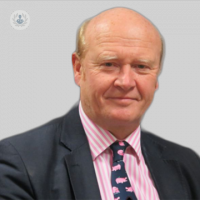How do I know if a tummy tuck is right for me?
Written by:A tummy tuck (abdominoplasty) is a surgical procedure which thousands of people undego each year. Leading consultant plastic surgeon Mr Nicholas Parkhouse explains who is eligible for the operation and what happens during surgery.
What is a tummy tuck (abdominoplasty)?
An abdominoplasty is a surgical procedure which improves the shape and appearance of the abdomen. There are several ways of performing it, reflected in slightly different names such as full or mini-abdominoplasty, fleur-de-lys abdominoplasty, lipoabdominoplasty, high lateral tension abdominoplasty and so on.

As there are so many terms used, and even the same ones used differently by different people, it's well worth discussing exactly what has been agreed as part of the procedure. Some surgeons would include a procedure to lift and tighten the mons (the area immediately below a caesarean section scar) as part of a tummy tuck, whilst others would not. But common features of most tummy tucks are removing redundant skin and fat, tightening abdominal muscles if they have separated, and enhancing attractive contours of the tummy, like the edges of the rectus muscle (six-pack) or a midline indentation.
Who is eligible for a tummy tuck and is there a size requirement for surgery?
A patient needs to be physically and psychologically fit for surgery - that is, not to have any serious uncontrolled illness and to have a realistic understanding and expectation of surgery and the recovery period.
We tend to think about size in terms of BMI (a measure of weight as a proportion of height) with the healthy range being 20-25. There isn't an absolute BMI cut-off for surgery and practice is quite variable amongst surgeons, but we know from the medical evidence that the complication rate increases sharply when BMI exceeds 30, so many consider that a reasonable threshold at which to offer or decline surgery.
I routinely accept patients with a BMI of up to 32, since overhanging abdominal tissue frequently contributes to BMI and is extra weight that typically does not respond to diet and exercise. Higher BMIs are also possible, so long as the patient is aware of the higher complication rate and accepts this risk.
What happens during a first consultation?
At the first consultation we discuss your aims of surgery, your reason for seeking it, your background health, surgical history and smoking status, your pregnancy history and whether you have completed your family, your work and home situation and how the recovery period might affect you.
There is also an examination during which your aims for surgery are assessed in more detail, including whether these can realistically be attained and the best method for doing so. We then discuss the risks and potential complications of your specific surgical plan, and this is followed up by a letter recapping everything, a quote for surgery and some further written information about the procedure.
If after that you wish to proceed then we arrange a second consultation to finalise the plan and answer any questions you may have thought of. I like to give no new information on the day of surgery, so it's important to thrash through all questions in advance!
How is the procedure performed?
The procedure is performed under general anaesthetic and you are admitted to the hospital, usually for two nights.
What happens after surgery?
After surgery, you are placed into an abdominal binder and will have two drains. The first is typically removed the day after surgery and the second the following day, although sometimes if there is continued drain output you may go home with one drain. I visit you each day whilst you are in the hospital. You are given strong painkillers in the first few hours after surgery but this is rapidly reduced to simple regular painkillers that you will continue at home. You will be mobile almost immediately although may need to walk around stooped as your tummy can feel tight at first (this lasts up to two weeks).
Once you leave the hospital, you are seen back in the clinic after a week and then again after a month. You usually feel ready to drive a car within two or three weeks and can often get back to office work in the same kind of time. I recommend you pause gym membership for six weeks and gently increase gym activity between 6-12 weeks. If you have had a muscle tightening procedure you should notice an improvement in back pain and that it becomes easier to strengthen your core than was previously the case.
If you would like to book a consultation with Mr Parkhouse, simply visit his Top Doctors profile today.


